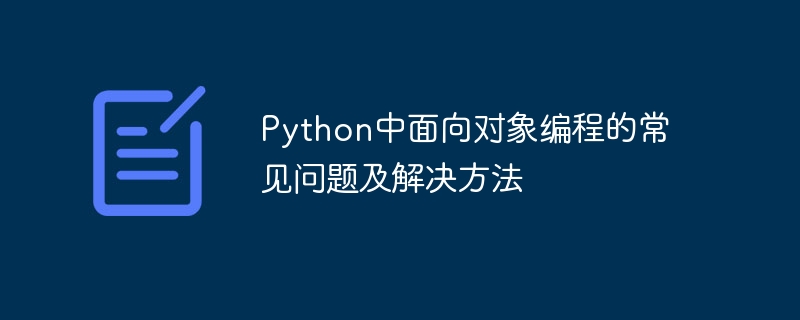Home >Backend Development >Python Tutorial >Common problems and solutions to object-oriented programming in Python
Common problems and solutions to object-oriented programming in Python
- PHPzOriginal
- 2023-10-08 08:10:081161browse

Common problems and solutions to object-oriented programming in Python
Introduction:
Object-Oriented Programming (OOP) is a programming paradigm , it encapsulates the data in the program and the operations on the data in objects, and implements it by defining classes and creating objects. As an object-oriented language, Python provides powerful object-oriented programming support. However, there are some common problems that may arise when using Python for object-oriented programming. This article will introduce some common object-oriented programming problems and provide corresponding solutions and specific code examples.
Question 1: How to define a class?
Solution: Use the keyword class to define a class, and add the parent class (if any) that the class name inherits after the class name. Define methods and properties in the class, as well as the initialization method __init__.
Specific example:
class Person:
def __init__(self, name, age):
self.name = name
self.age = age
def introduce(self):
print(f"Hi, my name is {self.name} and I am {self.age} years old.")
person1 = Person("Alice", 25)
person1.introduce() # 输出:Hi, my name is Alice and I am 25 years old. Question 2: How to create an object?
Solution: Use the class name followed by a pair of brackets to create an object and pass the parameters required by the initialization method.
Specific example:
person2 = Person("Bob", 30)
person2.introduce() # 输出:Hi, my name is Bob and I am 30 years old. Question 3: How to access the properties and methods of the object?
Solution: Use the dot operator (.) to access the properties and methods of the object.
Specific example:
print(person1.name) # 输出:Alice person2.introduce() # 输出:Hi, my name is Bob and I am 30 years old.
Question 4: How to inherit a class?
Solution: When defining a subclass, pass the parent class as a parameter to the subclass.
Specific example:
class Student(Person):
def __init__(self, name, age, grade):
super().__init__(name, age)
self.grade = grade
def introduce(self):
super().introduce()
print(f"I am in grade {self.grade}.")
student1 = Student("Tom", 15, 9)
student1.introduce() # 输出:Hi, my name is Tom and I am 15 years old. I am in grade 9. Question 5: How to override a method?
Solution: Define a method with the same name as the parent class in the subclass to override the method.
Specific example:
class Employee(Person):
def __init__(self, name, age, job_title):
super().__init__(name, age)
self.job_title = job_title
def introduce(self):
print(f"Hi, my name is {self.name}. I am a {self.job_title}.")
employee1 = Employee("John", 40, "manager")
employee1.introduce() # 输出:Hi, my name is John. I am a manager. Question 6: How to use class variables and instance variables?
Solution: Variables declared in a class are called class variables and can be accessed through the class name and instance. Variables defined in the initialization method are called instance variables and can only be accessed through the instance.
Specific example:
class Circle:
pi = 3.14
def __init__(self, radius):
self.radius = radius
def calculate_area(self):
return Circle.pi * self.radius * self.radius
circle1 = Circle(5)
print(circle1.calculate_area()) # 输出:78.5
print(Circle.pi) # 输出:3.14 Question 7: How to define class methods and static methods?
Solution: You can use @classmethod and @staticmethod decorators to define class methods and static methods.
Specific examples:
class MathUtils:
@staticmethod
def add(a, b):
return a + b
@classmethod
def multiply(cls, a, b):
return a * b
print(MathUtils.add(2, 3)) # 输出:5
print(MathUtils.multiply(2, 3)) # 输出:6Conclusion:
This article introduces some common problems and solutions to object-oriented programming in Python, and provides corresponding code examples. I hope this article can help readers better understand and apply object-oriented programming in Python. But be aware that you may encounter more problems and challenges in actual programming, and it requires continuous learning and practice to gradually master the essence of this programming paradigm.
The above is the detailed content of Common problems and solutions to object-oriented programming in Python. For more information, please follow other related articles on the PHP Chinese website!

